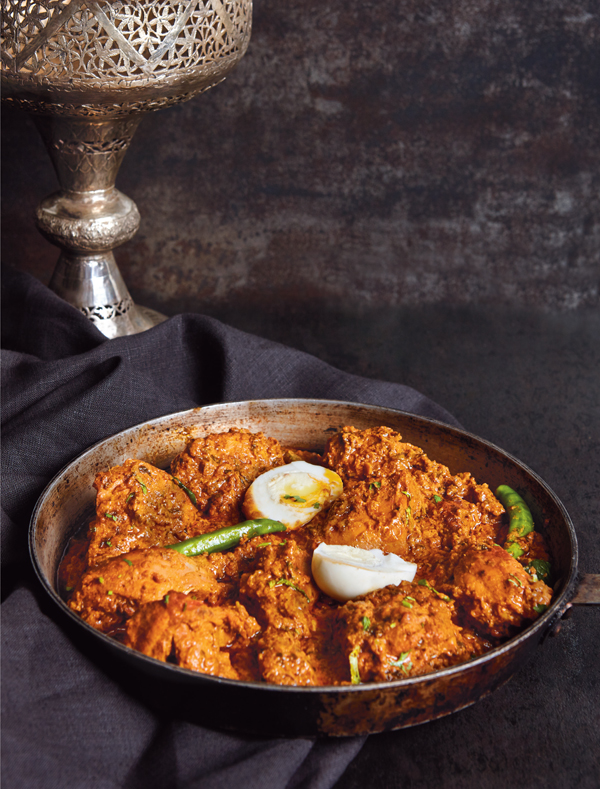

'PETER ALWAYS LOVED TO HOST PEOPLE'
As I was researching the book, I spoke to Karki Hassan, who is Peter’s cousin’s wife and I call her Karki Bhabhi. She and her late husband, Abid Bhai, literally brought Peter up as one of their own when he was a young man, staying with them in Vizag at his first job. Before Peter and I were engaged, he wanted me to meet them and get their blessings without which, he said, we could not get married. I learnt later that he was joking but Karki Bhabhi still talks about how she remembers me as a ‘terrified young lady with two plaits, who was afraid she would not be approved of’. Of all the meals I have made for her, she says her favourite is Shepherd’s Pie. This is a note she shared with me for the book, about her memories of Peter and myself –
‘People always say that behind every successful man is a woman but in the case of Peter and Doreen, I would say that they have both been very supportive of one another. Peter was a very devoted son and brother, and has remained devoted in all his roles. The Hassans are a very large Hyderabadi family with a very modern outlook and this has been so over the generations. Ours is a very multi-cultural, secular family and this has been true for generations. We like maintaining family ties and are very conventional only in this respect. And Doreen, with her Goan roots, fit right into the family from the start.
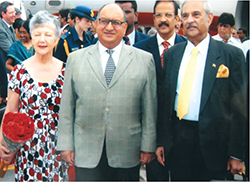
With Rt. Hon. Sir Anand Satyanand and Lady Susan
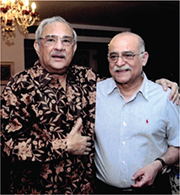
With Habib Rehman
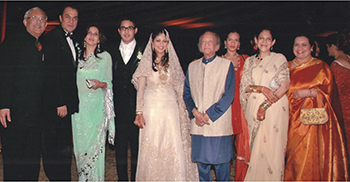
With Pt Ravi Shankar Ji, Smt. Sukanya Shankar and Anoushka Shankar
Peter has always loved hosting people. It is a part of his personality. I remember that at the start of his career when he had very little money, he would organize a tea party every couple of months and offer his guests cakes, something savoury and tea. He genuinely has always loved bringing people together. And Doreen has been a perfect partner for him. What has been very surprising for me is Doreen’s ability to cook traditional meals. The Hassans are a foodie family – as we eat one meal, we’re planning the next one – but Doreen was not a foodie when she married Peter. She doesn’t even eat meat! So, it’s only because of her wonderful personality that she has collected these precious recipes from aunts, cousins and other family members. She did it with so much grace, requesting them for their signature recipes, learning from them patiently and winning their generosity.
Doreen and Peter are now considered among the finest hosts in Delhi and are known for serving authentic, delicious Hyderabadi food. More than that, I think what they are loved for is their ability to bring people together over meals, and they do for the joy of it. Anyone can organize a meal and call people home but what makes their home special is the family’s hospitality. Everyone makes you feel welcome. The little grandchildren are running around. The food is the best and the hosts are personally making sure that their guests are feeling at home. In a city like Delhi, which is a powerhouse, they have created a world for themselves.’
COMING FULL CIRCLE
When I was thirteen, my father sent me off to the family’s farm. He wanted me to learn how to cook and spend some time with our relatives. I was the youngest person there, and missed my parents and brothers. I remember calling my mother to tell her – ‘You teach me how to cook, please! I just want to come home.’ And I did go home very soon after but before I left, my aunt, Suraiya Hassan Bose, taught me how to make Kofte ka Saalan, which is one of her signature dishes. ‘Beta, you must never use more than quarter kg of meat to make this dish,’ she said to me as we cooked together. I promised never to, though I don’t know why she said that and still have no idea.
Back in Delhi, my father wanted to know what I had learnt to make from Suraiya Apa and immediately asked me to cook it for a dinner party for fifteen people that he was hosting at home that evening. Of course, I had to use more than a quarter kg of meat, breaking my promise to Suraiya Apa almost immediately after making it. But this is life with my father – a full house and a full table, always. No one leaves our home without eating a meal. In fact, I don’t think there was ever a time that it was just the five of us at the table. One evening, it was just the family sitting down to dinner and my father remarked – ‘Who died? Why is there no one else joining us?’ And just then, the doorbell rang and extra places had to be set for two friends who had decided to drop by.
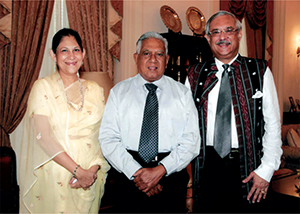
With President S.R. Nathan
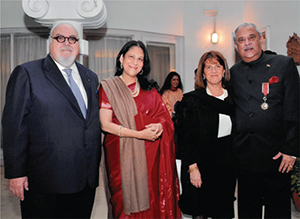
Peter receiving the ‘Order de Mayo – Officer of the Order’ from Ambassador of Argentina, H.E. Ernesto Alvarez in 2012
I’ve been married for a little over two decades now and my own home in Goa is an extension of my parents’. There’s always a meal for anyone who comes by and I love having people over. It’s also the same spirit of hospitality that inspires Saligao Stories, a restaurant that I opened in 2016 in my great-grandmother’s home in Saligao, Goa and where we serve both Goan and Hyderabadi cuisines. To me, it feels like coming full circle – from being that young girl who learnt to cook from her great-aunt, to now rustling up saalans, biryanis and curries as a restauranteur. Food truly is the greatest bridge and I believe I have been given a rare and blessed opportunity to be able to share our family’s stories, through our favourite dishes.
Anisha Hassan Mendes
TAS KABAB
INGREDIENTS
1 kg mutton (pasinda meat)
1 kg onions, finely sliced
1 cup oil
150 gm coriander leaves, chopped
8 green chillies, slit
4 limes, juiced
For the dough to seal the pan
As much wheat flour and water as you need
For the whole garam masala
10 cloves
6 cardamoms
4 1" cinnamon sticks
2 teaspoons peppercorns
METHOD
Mix the meat with salt and lime juice; keep aside for 30-60 minutes.
Heat oil in a pan and sauté half the onions until they turn translucent. Remove onto a plate lined with absorbent paper, and set aside.
Fry the other half to a crisp, golden brown in the same oil. Remove onto a separate plate lined with absorbent paper, and set aside.
Pour half a cup of oil into a large lagan or flat pan. Carefully arrange the meat pieces to cover the entire base of the vessel.
Cover the meat with both the browned, and slightly fried onions. As you sprinkle the slices, make sure you coat every inch of the meat.
Top the onion mixture with coriander leaves, green chillies, and whole garam masala. This has to be done in layers so please divide the ingredients accordingly. Do not use everything up in one layer
Repeat this process until you have used up all the ingredients.
Pour the lime juice and salt mixture, which the meat was marinated in and the remaining half cup of oil over the meat and its garnishes. Cover with water.
Seal the lagan with the dough; place on the fire with coals placed above and below it. You can also cook this dish in an oven, at 190° Celsius. Either way, it takes 30-45 minutes for the meat to brown.
Check the meat is cooked, allow the top to brown slightly.
Serve garnished with more chopped coriander leaves.
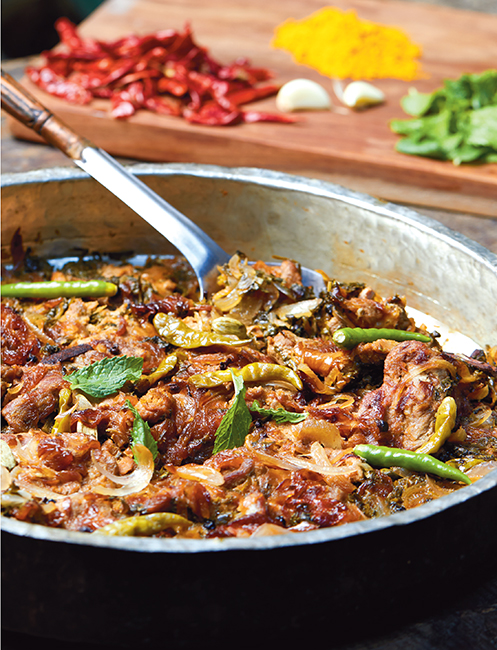
SANCHA GOSHT
INGREDIENTS
5 kg mutton, cut into strips
For the marinade
15 tablespoons ginger-garlic paste
3 tablespoons papaya paste
Salt to taste
To cook the meat
200 gm Bengal gram, ground and strained
100 gm yogurt
3 eggs
4 tablespoons oil
7 teaspoons chilli powder
6 teaspoons garam masala powder
2 teaspoons cumin powder
2 teaspoons coriander powder
1 teaspoon lemon yellow food colour
Handful of cashew nuts, ground into a paste
METHOD
Mix the marinade ingredients with the meat and keep aside for one hour. Drain off and discard any liquid that might be released at the end of the hour. Mix the rest of the ingredients together in a deep dish or bowl with a lid, and place the marinated strips of meat in this mixture.
Keep the bowl, covered, in the refrigerator overnight. When you are ready to cook the meal, heat coals on a sancha. Grill the meat strips until brown on both sides. Squeeze lemon over the grilled meat and serve hot.
PATTHAR KA GOSHT
INGREDIENTS
2 kg mutton (steak or pasinda cut)
2 tablespoons papaya paste
2 tablespoons garam masala powder
4 teaspoons black pepper powder
2 teaspoons black cumin seeds
2 teaspoons ginger-garlic paste
½ teaspoon all-spice powder
Salt to taste
METHOD
Wipe the mutton pieces with a wet cloth and then dry. Rub the papaya paste on the pieces and keep aside for two hours. Discard any liquid that might have collected. Mix in all the masalas with the meat; keep covered, overnight, in the fridge.
Heat a thick granite stone about 5" thick and keep the stone about 4" above coals to cook the gosht. Brush the stone with ghee and allow it to get very hot. At that point, place the meat on the stone and let it cook well on both sides. Brush more ghee on the stone as needed and repeat till all the meat is cooked. Serve garnished with onion rings and lemon squeezed over.
SHIKAMPURI KABAB
This is a never-fail party favourite. You can make a big batch of the mince ahead of time to store in the freezer. The filling needs to be freshly-made, just before you fry the kababs. I make it for hungry children – and adults! – and it’s also a great meal on the go.
INGREDIENTS
½ kg minced mutton
16 green chillies
16 pods of garlic
2 onions, peeled and left whole
2 onions, sliced and deep-fried
1 bunch coriander leaves
½ bunch mint leaves
12 cashew nuts
4 cardamoms
4 cloves
2 1" cinnamon sticks
4 tablespoons gram dhal
2 tablespoons poppy seeds
½ teaspoon black cumin seeds
For filling
100 gm yogurt or juice of two limes
½ bunch coriander leaves, finely chopped
1 onion, finely chopped
2 green chillies, finely chopped
METHOD
Roast the poppy seeds lightly; grind into a fine powder and keep aside. Take out a tablespoon of raw mince and keep aside.
Place the rest of the mince in a deep pan or vessel and add two whole onions, the green chillies, the pods of garlic, half a bunch of mint leaves, cashew nuts and four tablespoons of gram dhal.
Cover with enough water to boil in and add two tablespoons of oil. Bring to a boil, lower the heat and cook until the meat is done and all of the water dries up. In a separate pan, heat a tablespoon of oil and sauté the cooked, seasoned mince until all of the moisture evaporates.
Grind the mince along with the poppy seeds, a handful of fried onions, and all of the cardamoms, cloves, cinnamon sticks and black cumin seeds. At this stage, the mince can either be refrigerated to be used in a few hours, or frozen. You can make also oval shapes of the mince, skip the filling and fry them to make shami kababs.
TO ASSEMBLE THE KABABS
Thaw the mince completely, if it was frozen. Prepare the filling by mixing all the raw ingredients together. Shape a portion of mince into a ball. Create a hollow in the centre, place a little filling in it and wrap the mince around it. Flatten to form a round patty. Shallow fry the kababs in batches to ensure each one is well-browned on both sides.
Serve garnished with onion rings and, if you like, squeeze a little lime juice over the kababs.
NARGISI KABAB
INGREDIENTS
1 kg minced meat
¼ kg yogurt
¼ kg ghee
¼ kg onions
8 green chillies, finely chopped
6 eggs, hard boiled and shelled
2 bunches coriander leaves, finely chopped
1 bunch mint leaves, finely chopped
5 tablespoons chana dhal
4 teaspoons ginger-garlic paste
1 teaspoon chilli powder
1 teaspoon saffron strands, melted in a little water
Salt to taste
Roast lightly and grind together
6 teaspoons chironjee
5 teaspoons poppy seeds, soaked
1 teaspoon all-spice
Grind together
8 cloves
8 cardamoms
4 1" cinnamon sticks
1 teaspoon black cumin seeds
METHOD
Wash minced meat and grind well.
Roast and grind the chironjee, poppy seeds and all-spice to a fine paste. Add chana dhal and grind again to amalgamate.
Fry onions until brown and grind to a paste, using water.
Mix all the masalas and the yogurt with the ground minced meat. Coat the eggs with this mixture.
Grease a dish with ghee and place all the coated eggs in it. Pour the remaining ghee, chopped coriander and mint leaves, green chillies and saffron over the eggs.
Heat oil in a deep tawa or pan. Fry each egg until well-browned, and remove onto a plate lined with absorbent paper.
Cut each kabab into half, carefully, and plate on a bed of salad leaves.

TALA HUA GOSHT
INGREDIENTS
1 kg boneless mutton, cut into small pieces
2 bunches mint leaves, chopped
4 small bunches coriander leaves, chopped
6 sprigs curry leaves, chopped
2 cups water
½ cup ghee
4 tablespoons ginger-garlic paste
5 teaspoons red chilli powder
1 teaspoon turmeric powder
Salt to taste
METHOD
Mix the meat with ginger-garlic paste, turmeric powder and salt in a deep dish, and keep aside for at least 30 minutes. If you have the time, you can leave it to marinate for two hours, but not more than that. Mix half the chopped coriander, mint and curry leaves with the marinated meat. Cook the meat in a pressure cooker until the meat is tender and the juices dry up. This should take around 30 minutes.
Open the cooker once it is cool enough, heat ghee in a pan. Decant the cooked meat into the pan. Add in the chopped leaves that you had set aside earlier, along with green chillies, and red chilli powder. Let it cook on a medium flame until the gravy thickens. This should take about 15-20 minutes. Serve hot with rice or rotis of your choice.
ADRAK LASSAN GOSHT
INGREDIENTS
1 ½ kg yogurt
1 kg boneless mutton
¼ kg ginger-garlic paste
2 cups oil
Salt to taste
METHOD
Clean and cut the meat into small cubes. Place the meat cubes in a strainer and wash thoroughly. Let all the water drain off.
Heat oil in a pan and sauté the ginger-garlic paste until it browns. Then add the meat, yogurt and salt. Cover and cook on a low flame until the meat softens and all the liquid dries up. You will need to stir the dish often to prevent the yogurt from sticking to the pan. The oil will rise to the surface towards the end of cooking and, if you like, you can drain it off. This dish does not have much of a gravy and you can either serve it with rice and dhal, or roll the meat into a paratha with some chopped onions and mint chutney.
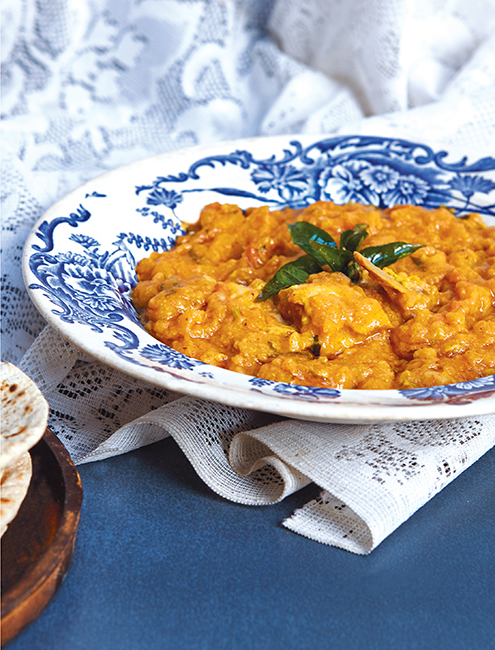
Adrak Lassan Gosht
PALAK GOSHT
This is our family’s version of a very classic dish. As with the Shahi Raan, it is best made for parties or other celebrations; serve with simple accompaniments to let the richness of the Gosht come through.
INGREDIENTS
1 kg mutton nalli and botis
¾ kg spinach
3 onions, finely sliced
5 cardamoms
4 cloves
1” cinnamon stick
2 heaped teaspoons chilli powder
2 teaspoons ginger-garlic paste
3 teaspoons oil
1 teaspoon coriander powder
½ teaspoon turmeric powder
Salt to taste
METHOD
De-stem the spinach leaves and roughly chop them.
Heat the oil in a pan and add the onions. When these start to turn brown, add in the whole spices, ginger-garlic paste and a few drops for water.
Sauté for a few minutes. Then add the powdered masalas, a little more water and add the meat.
Cook until there is no moisture in the pan.
Add salt, two cups of water and cover the dish. Turn the flame down and let it cook until the meat is nearly done. (If you prefer, you can do this in a pressure cooker.) When the meat is almost cooked, add the spinach leaves, cover the dish and let the greens wilt.
Serve hot with rotis.

SHAHI RAAN
Impressive, delicious and decadent, this is an ideal dish for parties. I like serving it with accompaniments that will highlight and not compete with its richness – white rice or a simple pulao, Khatti Dhal and a kachumber.
INGREDIENTS
½ kg leg of mutton, washed and dried
½ kg tomato puree
2 cups sour cream
1 cup yogurt
1 cup oil
4 glasses water
20 almonds, blanched
4 teaspoons ginger paste
3-2 teaspoons chilli powder
2 teaspoons garlic paste
1 teaspoon garam masala powder
Salt to taste
METHOD
Prepare the marinade by mixing tomato puree, sour cream, yogurt, ginger and garlic pastes, garam masala and salt. Set aside.
Use a fork to prick the mutton leg all over. Place in a deep dish and coat it with the marinade. Cover and keep aside for four hours. The meat can be marinated overnight and it will actually cook better so if you can do this ahead of time, please do.
TO COOK
Heat oil in a thick-bottomed pan. Place the mutton leg in the hot oil and cook until it is light-brown in colour, turning it on all sides to ensure it is evenly cooked through.
Addf the marinade and water to the pan, lower the flame and cook the meat until it is tender. You might need to turn it over a few times to make sure it does not stick to the pan, or burn. When the gravy thickens and coats the meat completely, the dish is ready.
Garnish with blanched almonds and serve.
MUTTON CHAAP
INGREDIENTS
1 kg pasinda meat
1 cup water
½ cup oil
2 tablespoons ginger-garlic paste
1 tablespoon coriander powder
1 tablespoon red chilli powder
1 teaspoon cumin powder
1 teaspoon black pepper powder
1 teaspoon garam masala powder
Salt to taste
For garnishing
½ kg onions, finely sliced
½ kg potatoes, finely sliced
3 tomatoes, finely sliced
METHOD
Wash meat well. Place it in a pressure cooker and add ginger-garlic paste, coriander powder, cumin powder, garam masala powder, water and salt. Pressure cook for three whistles and take the cooker off the flame. Once the pressure reduces, open the cooker and place it back on the stove, with the lid off. Cook on a low flame until much of the liquid evaporates, and there’s about a tablespoon of gravy coating the meat.
Heat oil in a kadhai as the meat cooks on a low flame. Sauté the onion slices until they turn transparent. Remove onto a plate lined with absorbent paper, and set aside. In the same oil, shallow fry the potatoes until they turn crisp and light brown in colour. Remove onto a separate plate lined with absorbent paper. Finally, fry the tomatoes for a quick minute, just to soften the slices and decant onto a third, lined plate.
Take the meat out of the cooker and sauté it in the same oil until all the moisture dries up. Sprinkle with chilli powder as you sauté it.
Place the meat in a flat, wide dish. Cover it with the potatoes, then the onions and finally the tomatoes. This is traditionally served with rice and Khatti Dhal (page 50).
Tip: The leftovers from this dish can be made into a delicious meal. Cut the meat into small pieces and sauté in a pan with two tablespoons of oil. Break two eggs into the pan and scramble well with the sautéed meat. This can either be used as the filling for rolls, or served with parathas on the side.
GOSHT KI KADHI
INGREDIENTS
½ kg seene ka gosht, or mutton ribs
½ kg tomatoes, finely chopped
1 bunch curry leaves
1 bunch coriander leaves
10 green chillies
2 medium-sized onions, finely sliced
5 cups water
2 cups tamarind juice
¾ cup rice
½ cup oil
3 tablespoons coriander powder
3 tablespoons cumin powder
2 tablespoons chilli powder
2 teaspoons turmeric powder
METHOD
Wash the meat with the sliced onions and then drain. Add chilli powder, turmeric powder, salt and tomatoes. Pressure cook the meat till it is soft. Soak the rice in two cups of water for about an hour. Grind to a fine paste and add two cups of water.
Heat oil in a pan and add the meat. Sauté until the oil rises up to the surface and then add coriander and cumin powders, curry leaves and green chillies. Finally, add the tamarind juice and a cup of water. When it comes to a boil, pour in the rice paste in a slow stream. Mix well and simmer for 15 minutes. This dish is best served with plain white rice.
DHANIYA KHORMA
INGREDIENTS
1 kg mutton bone marrow and gizzards
2 large onions, ground
2 large onions, sliced
2 cups yogurt
4 tablespoons coriander powder, not roasted
4 teaspoons ginger-garlic paste
2 teaspoons chilli powder
For the garam masala
4 peppercorns
4 cardamoms
2 cloves
½ teaspoon black cumin seeds
METHOD
Heat oil in a pan and fry the onions until golden brown. Remove onto a plate lined with absorbent paper. To the same pan, add the meat and ginger-garlic paste; cover and cook for 20 minutes. Then, add the ground onion, mix well and cover again. Cook further for 20 minutes.
Sprinkle in the coriander and chilli powders. Add yogurt and a little water. Cook until the meat is soft and a rich gravy forms – this takes about 20 minutes. Add the fried onions and garam masala. Keep the dish on dhum for 5 minutes, and it’s ready to serve.
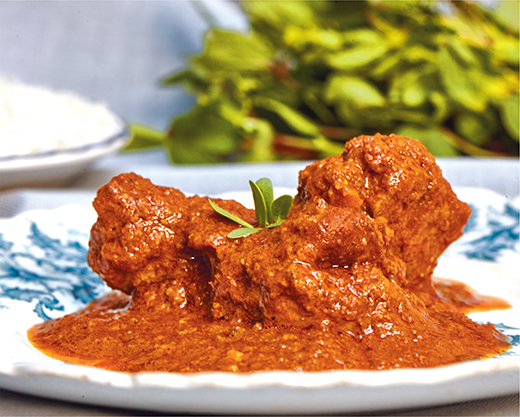
Gosht Ki Kadhi
NALLI GOSHT
INGREDIENTS
2 kgs lamb shanks (about 15 pieces)
2 litres mutton stock
½ kg yogurt
150 gm onions, chopped
100 gm onions, finely sliced
100 gm Kashmiri chilli paste
75 gm garlic cloves
1 gm saffron strands
100 ml oil
1 bunch coriander leaves, finely chopped
1 2" piece ginger, cut into strips
8 green cardamoms
5 1" cinnamon sticks
5 cloves
5 bay leaves
5 drops vetiver
8 tablespoons ginger-garlic paste
4 teaspoons kewda water
4 teaspoons rose water
1 teaspoon garam masala powder
1 teaspoon black pepper powder
1 teaspoon green cardamom powder
METHOD
Fry the chopped onions until very crisp. Remove onto a plate lined with absorbent paper.
Fry the garlic cloves until they turn a deep brown. Grind these along with the fried onions with a little water to form a paste.
Heat oil in a pan and add the whole spices. When it splutters, add in the finely sliced onions and fry them to a golden brown. Then, add the ginger-garlic paste and the lamb shanks first. Mix well and add salt and chilli paste. Let the meat cook until the spices coat it – this should take about 15 minutes.
Mix in the browned garlic and onion paste and yogurt. Leave it on a low heat for 15-20 minutes. Pour in the stock and seal the pan with dough. Lower the flame completely and let cook until the mutton is tender. This should take 20-30 minutes. Check if the meat is soft, and if it is not, please return the pan to the stove for another 15-20 minutes.
Strain the stock, remove the lamb shanks and set them aside. Pour the stock into a thick-bottomed pan and return to the stove; let it reduce to the thickness you would prefer for the gravy. Check the seasoning and add the lamb shanks back in.
Sprinkle with the cardamom powder, garam masala powder, kewda water, rose water, vetiver and saffron. Mix well to combine and take the pan off the flame. Serve garnished with chopped coriander leaves and ginger strips.
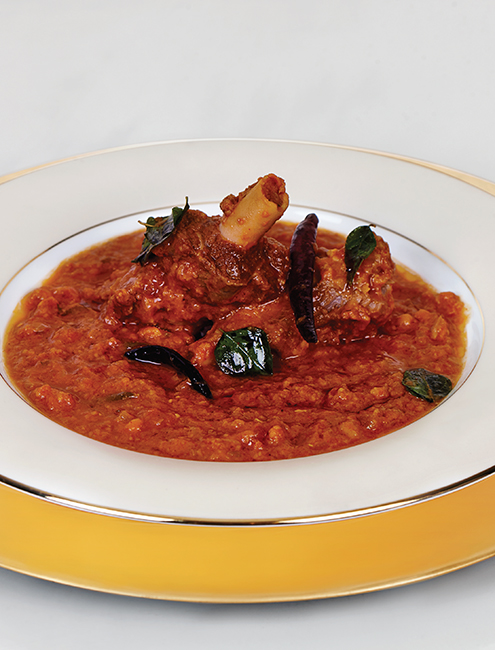
KALI MIRCH RAAN
INGREDIENTS
2 raans, weighing about 2 ½ kg each
1 kg new potatoes
2 litres water
1 cup oil
5 level tablespoons ginger-garlic paste
2 tablespoons freshly ground pepper
Salt to taste
METHOD
Clean and wash the raans well. Boil the potatoes and let them cool. Peel and set aside. Place the raans in a large pan and pour in the water. Add salt and ginger-garlic paste.
Cook the raans on a slow flame until the meat softens and the water reduces to nearly ¾ its original volume. At this point, pour in the oil and bring back to a boil. When the liquid starts to boil, add the potatoes and pepper. Reduce the heat again and cook for 15 more minutes, until the gravy is quite thick. Serve garnished with more pepper, if you would like some more spice.
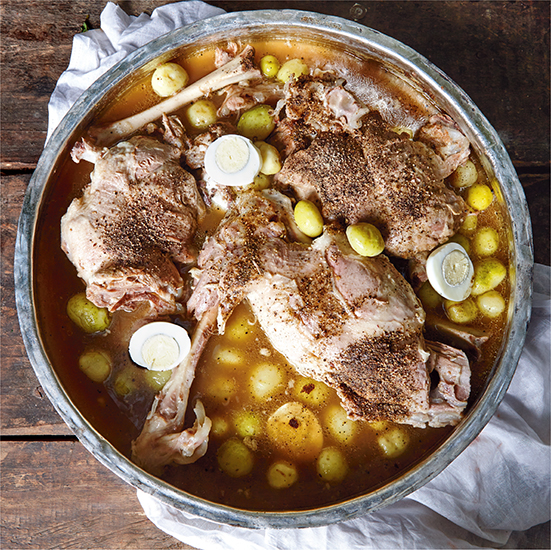
Kali Mirch Raan
MUTTON ISTEW
INGREDIENTS
1 kg marrow bones
100 gm French beans
100 gm carrots
1 potato, cubed
1 cup milk
2 1" cinnamon sticks
4 cardamoms
4 cloves
2 bay leaves
1 tablespoon ginger-garlic paste
1 teaspoon pepper powder
1 tablespoon butter
1 tablespoon maida
Salt to taste
METHOD
Heat the butter in a pan and toss in the whole spices first. When fragrant, add the ginger-garlic paste. Sauté for a few minutes and then add in the meat. Once the meat turns brown, pour in three cups of water and let it come to a boil. Now, lower the flame and let the meat cook.
Stir the maida into the cup of milk and make sure there are no lumps. When the meat is nearly done, add the vegetables and cook until soft. Pour in the milk and maida mixture and stir well to help it amalgamate. The gravy will thicken in a few minutes. Add the pepper before you take the pan off the flame. The Istew can be served in deep bowls, with bread on the side.
KOFTE KA SAALAN
INGREDIENTS
1 kg minced meat
¼ kg yogurt
2 large onions, finely sliced
½ dried coconut, roasted and ground
¼ cup oil
6 tablespoons Bengal gram, roasted and ground with very little water
5 teaspoons poppy seeds, roasted and ground with very little water
5 teaspoons chironjee, roasted and ground
2 teaspoons ginger-garlic paste
2 teaspoons red chilli powder
Salt to taste
To make the garam masala
10 whole cardamoms
6 cloves
3 1" cinnamon sticks
1 teaspoon black peppercorns
½ teaspoon turmeric powder
To make the green masala
1 cup coriander and mint leaves
5 green chillies
To garnish
4 green chillies, slit
Chopped coriander and mint leaves
METHOD
Grind the minced meat to a fine consistency without using water. This is best achieved on a masala grinding stone. Keep the mince aside. Again, on the grinding stone, grind the ingredients for the green masala, along with peppercorns and all the ingredients for garam masala. Scoop up into a bowl. Now, measure out half the paste into a separate bowl and keep aside.
Mix the chironjee, poppy seeds and chana dhal that you had roasted and ground earlier. Now, measure out half the mixture and place it in a separate bowl. In a large bowl, place the mince, one half of the green masala and one half of the powdered masalas. Mix the mince and the masalas as though you are kneading flour. This gives the mince a soft consistency and allows the ingredients to mix well.
Make small koftas of the mince and keep aside. Heat oil in a pan and fry the sliced onions until they turn golden brown. Then add the ginger-garlic paste, red chilli powder and turmeric powder; sauté well until fragrant. Now add in the second bowl of green masala and the second bowl of powdered masala. Add in the coconut. Continue sautéing the masala to allow the flavours to blend well. Then, add yogurt and mix well again. Once the oil rises to the surface, add the koftas, one at a time – they must not break.
Pour in two glasses of water and cook on a slow flame. If you need to mix the koftas in, do not use a spoon. Just hold the pan on both sides and gently shake it. When the gravy is thick and the oil rises to the surface again, add the green chillies, coriander and mint.
Serve with hot white rice.
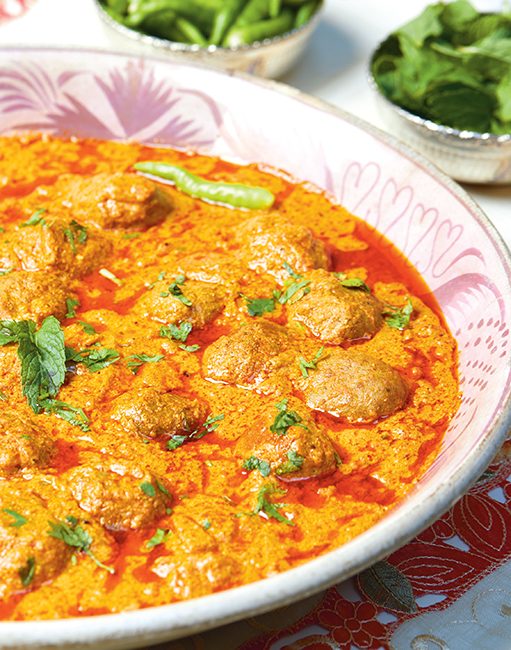
SALIM BAKRA
From the time I became a proficient enough cook to begin hosting people, my day has always been punctuated by a call from my husband, announcing that he was bringing guests home for dinner. The numbers can vary from four to forty, or even more.
So, one day in 1986, Peter called me and said he had invited Mehdi Hasan, the famous ghazal singer, for dinner. He was to sing at our home, and there would be 100 guests in attendance. We had to serve a special meal. I decided to make a Salim Bakra, which is an entire goat, stuffed with chicken and eggs, and cooked to perfection. It is a difficult dish to make but it’s perfect for special occasions and, of course, people cannot get enough of it.
As I prepared the goat, it occurred to me that I had come a long way from the young vegetarian girl who couldn’t cook at all to this woman who was bravely and efficiently preparing an extremely complicated dish without batting an eyelid. The truth is that when I started cooking meat, I could not even bring myself to touch it, so I would pay my neighbour’s maid a little money to clean and cut the meat for me. Making a dish like Salim Bakra by myself, therefore, was a proof of my journey. With 100 guests expected in a few hours, I couldn’t dwell on my achievements for long but I still remember how good I had felt making Salim Bakra that day.
It’s now a speciality of ours and Peter requested me to make it once for the Saudi Arabian ambassador, who was going to bring a friend along for dinner. I cannot remember the year now, but I will never forget the reaction of the ambassador’s friend. When he saw the Salim Bakra, he could not believe that I had made it. Through the whole evening, he kept repeating to Peter – ‘Your wife is a good woman.’ It’s become a favourite phrase of Peter’s and he is still fond of calling me a ‘good woman’.
If you are inclined to try making Salim Bakra – and I highly recommend you do – please ask for help and try it once before you cook it for an occasion. I would not advise you to experiment with this recipe. Follow the steps carefully, and don’t be daunted by it. If I could master it, so can you.
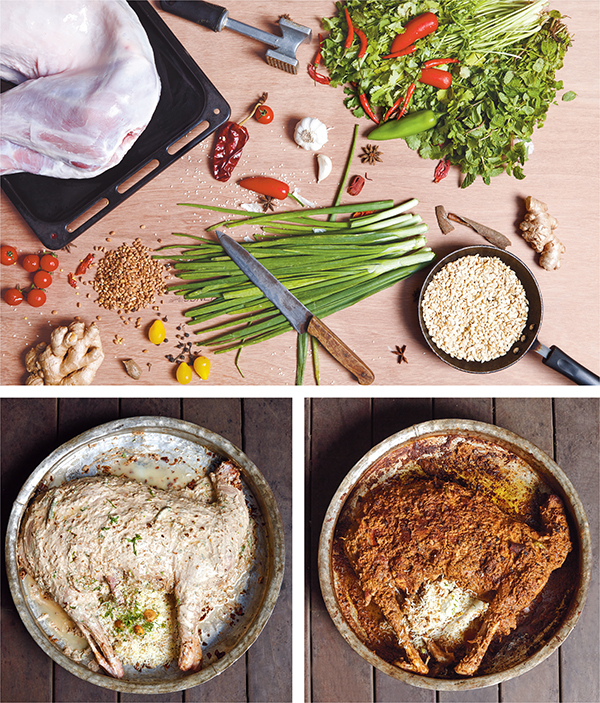
INGREDIENTS
1 goat, weighing about 6 kg
2 to 3 small chickens
1 dozen eggs
1 ½ kg onions
1 kg biryani rice
1 kg yogurt
¾ kg ghee
¼ kg ginger-garlic paste
5 to 6 limes
8 teaspoons red chilli powder
2 teaspoons turmeric powder
Salt to taste
Flour kneaded into dough
to seal the pot
Grind together and keep aside
5 tablespoons chironjee
5 tablespoons watermelon seeds
3 tablespoons almonds
1 teaspoon saffron strands, powdered
Grind together and keep aside
15 1" cinnamon sticks
6 dry apricots
5 tablespoons raisins
5 teaspoons cardamoms
5 teaspoons black cumin
5 teaspoons mace
Grind together and keep aside
100 gm coriander leaves
50 gm mint leaves
6 to 8 green chillies
METHOD
Clean the goat, including the insides of the stomach. Apply the ginger-garlic paste, garam masala powder and salt to the insides and on the body of the goat. Keep aside for 1-2 hours.
Parboil the biryani rice and keep aside.
Hard-boil the eggs. Combine them with the parboiled rice. Divide this mixture into two or three equal parts. Stuff each chicken with one part and stich it up once it is stuffed. Roast the chickens in ghee on a large pan until half-done.
Place the chickens inside the goat and stitch up the goat.
Pour ghee/oil in a large lagan and roast the goat until it is slightly brown.
Mix all the ground masalas with the yogurt and pour the mixture over the browned goat. Seal the lid of the lagan with dough and keep on slow coal fire with coals above and below and cook till the meat is tender.
Place the goat in the centre of a large, flat dish. Open the stitches up, take the chickens out to serve.
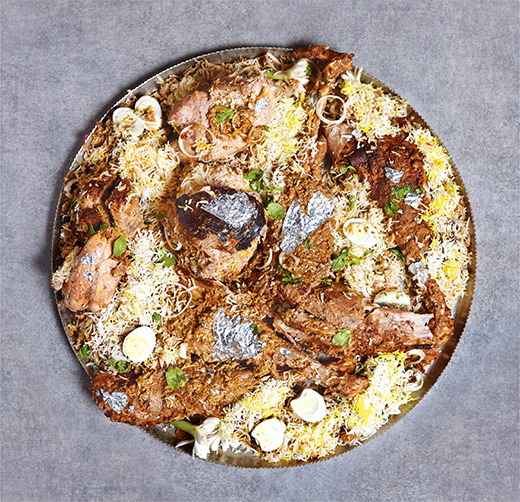
HALEEM
This is another quintessential Hyderabadi dish, which is traditionally eaten during Ramadan. This recipe is our family’s version of it. I often make it for dinner in winter because we find it to be a comforting, warming porridge. There are two components to this dish – the fermented wheat and the deeply flavoured Khorma. Make sure you eat Haleem as soon as it is made; you cannot store it even in the fridge for more than a day because the wheat will begin fermenting.
INGREDIENTS
2 kg boneless meat
1 kg wheat
½ kg sour yogurt
200 gm ghee
4 cups water
¼ cup oil
6 large onions, sliced
4 tablespoons cashew nuts
4 teaspoons ginger-garlic paste
2 teaspoons red chilli powder
1 teaspoon turmeric powder
1 teaspoon garam masala powder
Salt to taste
Lightly roast and grind together
8 cardamoms
2 tablespoons poppy seeds
2 tablespoons chironjee
1 tablespoon black cumin seeds
½ tablespoon coriander powder
Suggested accompaniments
A bowl of the whites of spring onions
A bowl of mint leaves
A bowl of radishes, sliced into strips
A bowl of fried onions
As many lemons as you’d like, halved
METHOD
Fill a large pan to the brim with water and soak the wheat in it overnight. The next morning, de-husk the wheat and pressure cook it until soft. Let it cool and then grind to as fine a consistency as possible. Ideally, it should resemble a thick porridge.
Heat oil and fry the onions until golden brown. Then, add ginger-garlic paste and chilli and turmeric powders. Fry until aromatic. Now, add the meat and fry until the water dries up. Then, add the masalas that you roasted and ground and allow the mixture to brown.
Add the yogurt and as much water as required for the gravy. I usually use five glasses of water. When the meat is cooked, add the garam masala and keep on dhum for a few minutes. Remove the pieces of meat and grind to a fine paste.
Heat 200 grams of ghee in another pan. Add the black cumin seeds and cardamom. Lastly, add the ground meat and gravy and mix well. Leave on dhum for 15 minutes.
Garnish the Haleem with fried onions and lemon juice. Serve with the accompaniments of your choice.
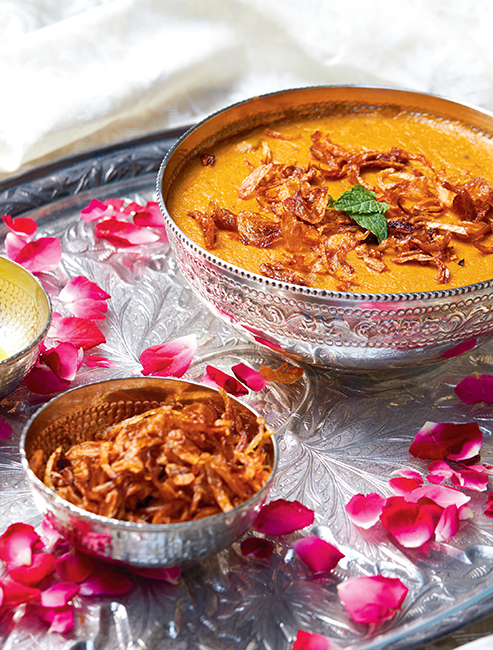
NEHARI
This is a very traditional recipe for a nourishing soup made with trotters and tongue. Nehari is a favourite of Peter’s, and I make it during the winters – as it is meant to be – and serve it with kulchas or Sheermals for dinner, because it warms you up and is very soothing. It can also be eaten at breakfast. Traditionally, Nehari was cooked all night in a large pot, but to suit modern kitchens and lifestyles, I have adapted the recipe to be made using a pressure cooker.
INGREDIENTS
2 dozen paya, or trotters, cleaned
2 dozen potla zaban, or tongues, cleaned
½ kg thick yogurt
2 cups chana dhal, ground to a fine paste
with water
1 cup ginger-garlic paste
1 cup coriander leaves
1 cup mint leaves
1 cup oil
3 green chillies
3 limes
10 cloves
8 cardamoms
6 cinnamon sticks
3 tablespoons coriander seeds
1½ tablespoons salt (or as required)
1 tablespoon chilli powder
1 teaspoon turmeric powder
1 teaspoon pepper
1 teaspoon black cumin seeds
For the potli masala
3 large onions, quartered
5 cloves
4 cardamoms
3 cinnamon sticks
1½ tablespoons coriander seeds
1 teaspoon black cumin seeds
1 teaspoon whole black peppercorns
To Make the Potli Masala
Spread a large square of clean white muslin cloth – ideally measuring 12"x12" – on your work surface. Place the masalas in the middle of it and bundle it up tight to form a potli. Tie it with a clean white string – make sure it is tightly wound so that the cloth does not loosen during cooking. Leave a long thread of string which you can use to fish the potli out of the pot when you are done with it. This is the Hyderabadi equivalent of a bouquet garni.
METHOD
Clean the trotters very well. (Refer to page 30 for my notes on this)
Roast the trotters well on an open flame, using a pair of tongs.
Place the trotters and the tongue in a large pressure cooker and add twelve glasses of water. Add the potli. Cook on a slow fire until the meat is tender. This should take about 30-45 minutes.
Open the cooker when the pressure reduces and remove the potli. Using a pair of tongs, squeeze it to remove any juices. You can then discard the potli.
Heat oil in a large, heavy-bottomed pan. Add cardamoms, cloves, cinnamon sticks and three small onions, sliced fine. Fry until golden brown, and then keep aside in a bowl to use later.
Add the ginger-garlic paste, turmeric and chilli powders to the same pan. Stir until aromatic. Now, add the yogurt and keep stirring until it turns red.
Add the cooked meat along with its juices. Season with salt and lime juice. Cook for 10 minutes on a low simmer, allowing it to come to a boil.
Put in the paste of Bengal gram that you prepared earlier when it starts boiling. Stir to bring all the masalas together and continue cooking on a low simmer.
Add the chopped coriander leaves, chopped mint leaves and three green chillies when the gravy starts thickening. You can choose to slit them if you like, but that makes the dish spicier. So, if you prefer, leave the chillies whole. Take the pan off the flame.
Nehari is best served in deep bowls, garnished with a swirl of fresh cream, if you want to be decadent. Those who wish to, can add more lime juice to taste.
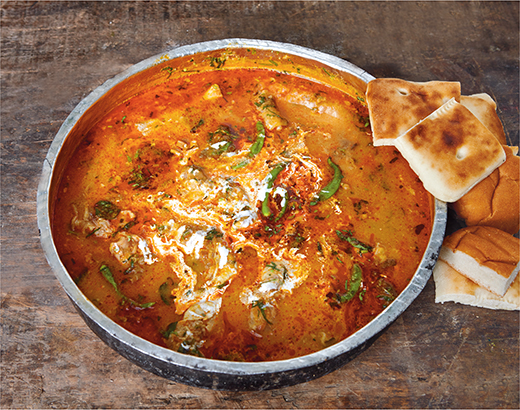
DHUM KA KHEEMA
My husband’s younger sister Chintara, whom we call Chintu, is an excellent cook. She used to help their father in the kitchen when she was young and when I got married, we became friends.
Chintu was working as a teacher at the time and was not married, so we all lived together. Whenever we had people over for dinner, she would cook the meal but go to bed early because she had to go to work the next day. I would serve the meals. When I started cooking in Delhi, I would ask Chintu for family recipes. She taught me what she knew and it helped that Peter used to buy her sarees sometimes, as a thank you. Chintu lives in Canada now and while writing this book, I found many old notebooks in which I had written her recipes. This is one of those and is one of her specialties.
Chintara makes the traditional version, which is cooked on coals and I, too, prefer cooking it that way. For convenience, I have added a version that can be baked, which is easier and quicker, but achieves the same silkiness and deep flavours.
THE BAKED VERSION
INGREDIENTS
1 kg minced meat
¼ kg onions, sliced fine
¼ kg thick yogurt
½ cup oil
8 cardamoms
8 cloves
2 1" cinnamon sticks
4 heaped tablespoons gram dhal
2 ½ tablespoons coconut powder
2 heaped tablespoons poppy seeds
1 heaped tablespoon chilli powder
1 teaspoon turmeric powder
1 teaspoon black cumin seeds
1 teaspoon all-spice
Salt to taste
For the marinade
2 heaped tablespoons papaya, ground into a paste with salt
2 heaped tablespoons ginger-garlic paste
METHOD
Prepare the marinade by mixing papaya and ginger-garlic pastes together. Place the meat in a deep bowl and apply the marinade; keep covered in the fridge for six hours. When you are an hour or 30 minutes away from the meat being ready, start prepping the spices and masalas.
Heat oil in a pan and fry the onions until they turn golden brown. Decant them onto absorbent paper. Let the oil cool and pour into a bowl. Keep it aside – you will need this oil later.
Roast the poppy seeds and coconut powder separately. Grind together into a fine paste, using as much water as you need. Just remember not to make the paste too thin. Grind cinnamon, cloves, turmeric, cardamom, black cumin seeds and chilli powder together and keep aside. Take the marinated kheema out of the fridge and transfer it into a dish that is oven-proof. Mix in the prepared masalas and pastes and then the yogurt. Pour over the oil that you fried the onions in. Check the seasoning – you may want to add more salt – and keep aside, covered, for 30 minutes.
Preheat the oven to 150° Celsius. Bake the kheema until the top is brown and the marinade has dried up. This usually takes 45 minutes to an hour. Check it at the 35 mark. You may need to baste the meat in a greased pan on the stove to allow the marinade to be completely absorbed, and give the dish a very dry consistency, which is ideal.
Serve garnished with white onion rings, slivers of lime and mint leaves.
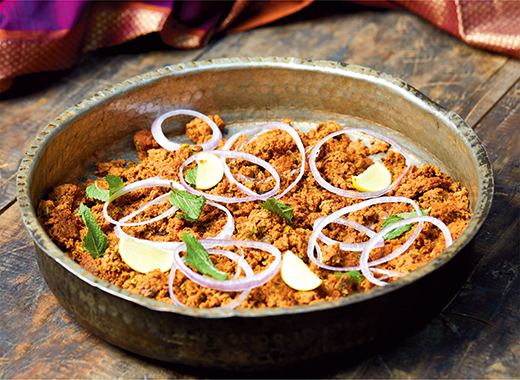
THE TRADITIONAL VERSION, COOKED ON COALS
INGREDIENTS
1 kg minced meat, from the thigh of the lamb
¼ kg yogurt
3 big onions, grated and fried
2 bunches coriander leaves, finely chopped
6 cashew nuts, ground to a fine paste
2 tablespoons Bengal gram, ground to a fine paste
3 teaspoons jalebi food colouring
2 teaspoons ginger-garlic paste
2 teaspoons chilli powder
Roast separately and grind together
4 heaped teaspoons poppy seeds
4 heaped teaspoons chironjee
1½ teaspoon all-spice
Grind, using water, into a paste
2 bunches mint leaves
25 peppercorns
10 cardamoms
5 1" cinnamon sticks
1 teaspoon black cumin seeds
METHOD
Do not wash the meat. Just wipe it with a damp cloth and store in the fridge for at least 30 minutes before you start preparing the dish. When you are ready to begin cooking, take the mince out of the fridge.
Place it in a deep dish and mix in all the ingredients – yogurt, onions, chilli and turmeric powders, and the ground pastes and spices. Add salt to taste and mix the ingredients well, like you are kneading a dough.
Grease a lagan and place the mince in it. Flatten it out and put a few drops of jalebi colour on top.
Squeeze the juice of a lime on top and drizzle two teaspoons of oil along the sides.
Make a hole in the centre and place two tablespoons ghee in it.
Heat a piece or two of coal (you will already have coal which is being heated to cook on). When the coal glows, drop it into the ghee or butter that you have placed in the dish.
Cover the lagan with a lid immediately, and hold the lid down tight. We do this to allow the smoke to permeate the meat, which adds depths of flavour. When the smoke disappears, remove and discard the onion skin and coal.
Seal the lagan with flour and place coals above and below it; cook for 35 to 40 minutes.
Serve the Dhum ka Kheema garnished with rings of onions, quartered limes and generous amounts of mint leaves on the side.
KALEJI GURDA
INGREDIENTS
¼ kg liver, cubed
2 kidneys, cut into 4 pieces
1 large onion, sliced
1 tomato, ground
4 tablespoons oil
2 teaspoons pepper powder
1 teaspoon ginger-garlic paste
1 teaspoon chilli powder
1 teaspoon garam masala powder
½ teaspoon turmeric powder
METHOD
Heat oil in a pan and fry the onion slices until they turn golden brown. Then add the ginger-garlic paste and turmeric and chilli powders. Sprinkle a little water and let the masala cook until it is aromatic.
Add the liver and kidneys; cook until the liquid dries up. Then, mix in the ground tomatoes. Simmer on a low flame until the meat is soft and well-coated with the masala. Finally, add pepper and garam masala powders and salt to taste.

Kaleji Gurda
SHEPHERD’S PIE – The Hassan Way
INGREDIENTS
For the kheema
1 kg kheema
500 gm tomato puree
250 gm onion
1 tablespoon ginger-garlic paste
2 teaspoons chilli powder
Salt to taste
For the mash
500 gm potatoes
250 ml milk
5 tablespoons breadcrumbs
1 teaspoon pepper
METHOD
Heat oil in a pan and sauté the onions till they turn a light brown. Add in the ginger-garlic paste. Mix in the chilli powder and kheema; cook on a low flame until the moisture in the meat dries out. Now, add the salt and tomato puree; cook until the mince is done. As the mince cooks, boil, peel and mash the potatoes. Set aside.
Heat butter in a pan and add the mashed potatoes. Pour in milk and mix. Add the pepper and salt. Mix well to combine and take the pan off the flame. Pre-heat the oven to 190° Celsius. Grease a baking dish with butter and decant the cooked mince into this. Top with the mashed potatoes. Bake for 15 to 20 minutes, until the mash is a deep brown.
MURGH KARI PATHA
INGREDIENTS
1 kg boneless chicken, cut into 1" cubes
¾ kg sour yogurt, beaten
20 dry red chillies, broken into medium-sized pieces
4 fistfuls fresh curry leaves
4 tablespoons oil
2 teaspoons ginger-garlic paste
Salt to taste
METHOD
Wash the chicken pieces well.
Mix the ginger-garlic paste with the yogurt, and marinate the chicken in it for 2-3 hours.
Heat oil in a pan. Toss in the broken red chillies and one fistful of curry leaves.
Add marinated chicken and sauté on a medium flame until the meat is half cooked.
Add the remaining curry leaves and cook the chicken until the juices dry up.
KADHAI MURGH
INGREDIENTS
1 boneless chicken, cut into small pieces
¼ cup oil
6 onions, finely sliced
6 medium-sized tomatoes, finely chopped
6 green chillies, finely chopped
3 pods garlic, finely chopped
1 bunch coriander leaves, finely chopped
1 small piece ginger, finely chopped
1 teaspoon red chilli powder
Salt to taste
METHOD
Heat oil in a pan. Add onions, ginger, garlic and tomatoes; fry until the tomatoes break down and are well amalgamated with the onions.
Add the chicken and red chilli powder; let the flavours begin to meld for a while. Cover and cook until the chicken is tender.
Add green chillies and coriander leaves. Allow the gravy to dry up, and the oil to rise to the surface.
Garnish with more coriander leaves.

Kadhai Murgh
IMLI MURGH
We ate this dish nearly every day in my home, when I was growing up. It has very Goan flavours and is light, delicious and easy to make. Because it needs very little oil, it’s also a healthy option and you can make it healthier by not frying the chicken at all, as I have explained in the recipe.
INGREDIENTS
1 whole chicken, washed and drained
5 whole dried red chillies
2 tablespoons oil
1 teaspoon whole black peppercorns
A fistful of tamarind, soaked in water and pulped
Salt to taste
METHOD
Rub salt all over the chicken – inside and outside. Set aside. You should have about three cups of tamarind water; if you don’t, use more tamarind and water to make more pulp.
Heat oil in a pan and throw in the whole red chillies and peppercorns. Then, add the chicken and let it turn a light brown. Or, you can let it fry for longer and get very brown.
Pour in the tamarind juice when the chicken is cooked to your preference.
Cover and cook until the chicken is tender and the sauce has thickened.
Debone the chicken, except for the legs, to serve.
Serve Imli Murgh on a bed of lettuce, with boiled peas and fried potatoes as accompaniments. Or, place it on a bed of mashed potatoes and scatter peas all around.
MURGH PASINDA
Mutton pasinda is a great favourite in our home but it can be a very rich dish. So, to preserve the flavours but make it lighter, I came up with this recipe, using chicken.
INGREDIENTS
1 kg boneless chicken
½ kg yogurt
½ kg oil
3 onions, sliced
3 green chillies
1 bunch coriander leaves, chopped
1 bunch mint leaves, chopped
2 teaspoons ginger-garlic paste
2 teaspoons red chilli powder
1 teaspoon garam masala powder
½ teaspoon turmeric powder
A pinch of salt
Lightly roast, and grind to a paste
2 tablespoons coconut powder
2 tablespoons poppy seeds
1 tablespoon charoli
1 tablespoon cashew nuts
METHOD
Wash the chicken pieces. Using a spatula, flatten each and keep aside.
Heat oil in a deep-bottomed pan, or tawa. Fry the sliced onions to a golden brown. Remove onto a plate lined with absorbent paper and let the fried slices cool slightly. Then crumble the fried onions into a rough powder and keep aside.
Strain the oil into a deep bowl. To it, add the chicken pieces, the roasted paste you made earlier, all the powdered masalas, yogurt, fried onions and ginger-garlic paste. Mix well.
Heat a pan. Arrange the chicken pieces on it and cook until tender and a thick gravy coats each piece. Mix in the chillies, coriander and mint leaves before taking off the fire.
TAMATAR MURGH
INGREDIENTS
1 chicken, cut into pieces
4 large tomatoes, pureed
2 onions, finely sliced
¼ cup oil
1" cinnamon stick
2 teaspoons ginger-garlic paste
2 teaspoons chilli powder
2 teaspoons garam masala powder
1 teaspoon black pepper powder
Salt to taste
METHOD
Wash the chicken pieces well.
Heat oil in a pan and add in cinnamon and onions; fry until the onions are golden brown.
Add the ginger-garlic paste, salt and red chilli powder. Sauté for a while, sprinkling a little water, if needed. Now add the chicken.
Leave the pan on a medium flame until all the moisture dries up. Pour in the tomato puree and cook until the chicken is tender.
Add the pepper and garam masala powders. The dish is done when the chicken is well coated with the masala and the oil rises to the surface. You can choose to drain off this excess oil.
Serve garnished with finely chopped coriander leaves.
SHAHI MURGH
INGREDIENTS
1 chicken, cut into 12 pieces
100 gm butter
1 cup fresh yogurt
1 cup milk
½ cup water
2 hard boiled eggs, shelled
1 bunch coriander leaves, finely chopped
1 small onion, grated
1 sprig curry leaves
6 peppercorns
4 cloves
2 cinnamon sticks
2 cardamoms
2 bay leaves
3 tablespoons cashew nuts
3 tablespoons almonds, blanched
1 tablespoon ginger-garlic paste
1 to 2 teaspoons plain flour
½ teaspoon cumin powder
Salt to taste
METHOD
Grind the blanched almonds with the cashews. Keep aside.
Place the chicken pieces and add grated onion, ginger-garlic paste, cumin powder, salt and a little water in a pan. Cook on a low flame until the chicken is tender.
Heat the butter in a separate pan when the chicken is nearly done.
Toss in the cinnamon sticks, cloves, cardamom, peppercorns, curry leaves and bay leaves. Once they stop spluttering, add the cooked chicken and the paste of almonds and cashews. Simmer for a while on low flame.
Beat the yogurt well and add to the pan. Cook for about 10 minutes more. In the meantime, dissolve the flour in the cup of milk. Slowly stir this paste into the pan to help thicken the gravy.
Cook for a few minutes and take off the flame.
Slice the boiled, shelled eggs into four long slices; garnish the dish with these and the coriander leaves.
MALAI KI MURGH
INGREDIENTS
1 chicken, washed and cut into 12 pieces
¼ kg fresh cream
1 cup water
¼ cup oil
2 onions, finely sliced
2 teaspoons red chilli powder
Grind to a fine paste
100 gm almonds
100 gm cashew nuts
50 gm raisins
METHOD
Heat oil and fry the onions until they turn light brown. Then, add the ginger-garlic paste and chilli powder; sauté until aromatic. Add the chicken pieces into the pan and cook for a while. Then, pour in as much water as is required to cook the meat, without too much gravy. I use three glasses of water.
Ready the dish for serving. Mix the ground almonds, cashew nuts, raisins and fresh cream in with the chicken and leave on slow fire until well-blended.
PALAK SOYA MURGH
INGREDIENTS
1 chicken, washed and cut into 12 pieces
1 cup yogurt
½ cup oil
2 bunches spinach leaves
1 bunch soya leaves
2 onions, sliced
2 cardamoms
2 cloves
2 1" cinnamon sticks
1 tablespoon ginger-garlic paste
2 teaspoons chilli powder
Salt to taste
METHOD
Chop spinach and soya leaves separately. Wash well, drain and keep aside. Heat oil in a pan and toss in the cardamoms, cinnamon and cloves. Add the sliced onion and fry until golden brown. Add the ginger-garlic paste and chilli powder. Sauté, sprinkling a little water at intervals. Now, add yogurt and let cook until the oil rises to the surface.
Add the chicken pieces to the gravy and cook for 15-20 minutes. Then, add the spinach leaves. When the chicken is nearly done, add the soya leaves. Cook until they blend with the spinach and the chicken is tender. If there is any extra moisture in the pan, allow it to dry up. Serve with hot white rice.
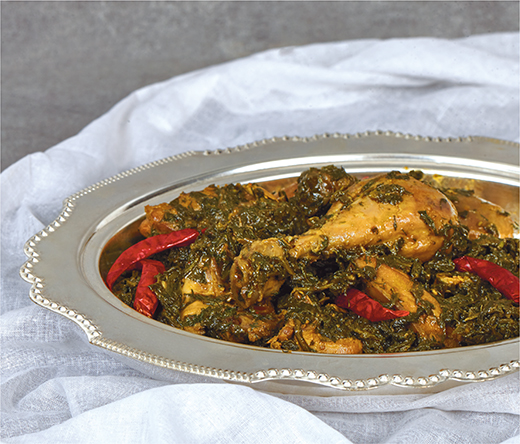
Palak Soya Murgh
KALI MIRCH MURGH
INGREDIENTS
1 chicken, cut into 12 pieces
2 cups yogurt
2 onions, finely sliced
3 tablespoons oil
2 tablespoons coriander powder
4 teaspoons black pepper powder
2 teaspoons ginger-garlic paste
1 teaspoon turmeric powder
1 teaspoon red chilli powder
1 teaspoon garam masala powder
Salt to taste
METHOD
Heat oil in a pan and fry the onions until golden brown. Add the ginger-garlic paste and turmeric and chilli powders. Sprinkle in a little water. Add the coriander powder and sauté until it turns a light brown.
Pour in the yogurt and cook until a gravy forms. Now, add the chicken pieces into the gravy and let them cook through. Then, add the freshly-ground pepper and garam masala powder. Keep on dhum for 5 more minutes. Serve garnished with finely chopped coriander leaves and some lemon juice poured over.
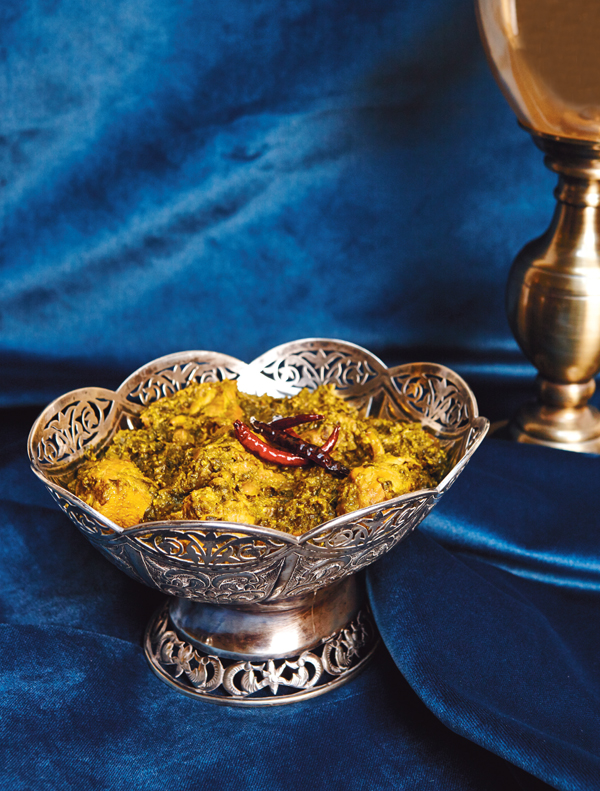
Kali Mirch Murgh
SHAHJAHANI MURGH
INGREDIENTS
1 whole chicken, washed and cut into 8 pieces
¼ cup oil
2 large onions, finely sliced
1 large tomato, finely chopped
1 large capsicum, finely sliced
12 garlic cloves, finely chopped
10 green chillies, finely chopped
1 bunch coriander, finely chopped
1 medium-sized piece ginger, finely chopped
3 cardamoms
3 cloves
2 cinnamon sticks
2 teaspoons coriander powder
½ teaspoon red chilli powder
½ teaspoon turmeric powder
Salt to taste
METHOD
Heat oil in a pan. Toss in cardamoms, cloves, cinnamon sticks and garlic; sauté for a minute or two. Add the ginger, green chillies, onions and salt. Mix in the chopped tomato and cook until it breaks down. Add the chicken and three cups of water, cook for 15-20 minutes.
Add the dry masala powders and make sure the chicken is coated with the spices. Do not add any water. Once the chicken is cooked through, add the sliced capsicum and continue to keep the pan on a slow fire until the capsicum slices soften.
NAWABI MURGH
INGREDIENTS
1 whole chicken
3 tomatoes, pureed
3 eggs, beaten
½ cup thick yogurt
2 tablespoons ginger-garlic paste
1 tablespoons garam masala powder
1 teaspoon chilli powder
Breadcrumbs, to coat
Oil for frying
Salt to taste
For the stuffing
½ kg chicken mince
1 bunch spring onions, chopped
1 bunch coriander leaves, chopped
2 green chillies
1 teaspoon ginger-garlic paste
½ teaspoon garam masala powder
Salt to taste
METHOD
TO PREPARE THE CHICKEN
Wash the chicken and prick it all over using a fork. Then tuck the neck in the breast and keep aside as you prepare the marinade.
Mix together the ginger-garlic paste, garam masala powder, tomato puree, yogurt, red chilli powder and salt. Rub this mixture on the chicken – inside and outside – and allow it to marinate for 30 minutes.
TO MAKE THE STUFFING
Mix the mince with ginger-garlic paste, ground garam masala and salt. Heat a pan, add the spiced mince, and cook on a low heat until the meat is dry. Take off the stove, add spring onions and coriander leaves. Keep aside.
To ASSEMBLE THE DISH
Heat a heavy-bottomed pan. Place the marinated chicken on it, and let cook until the marinade has dried up. Take the chicken off the pan, and let cool.
Stuff the chicken with the prepared mince, once it is cool enough to handle, and bind it with a sturdy thread. Dip the chicken in the beaten eggs, then in the breadcrumbs and again in the eggs. Deep fry until golden brown.
Serve garnished with tomato slices, onion rings and capsicum rings.
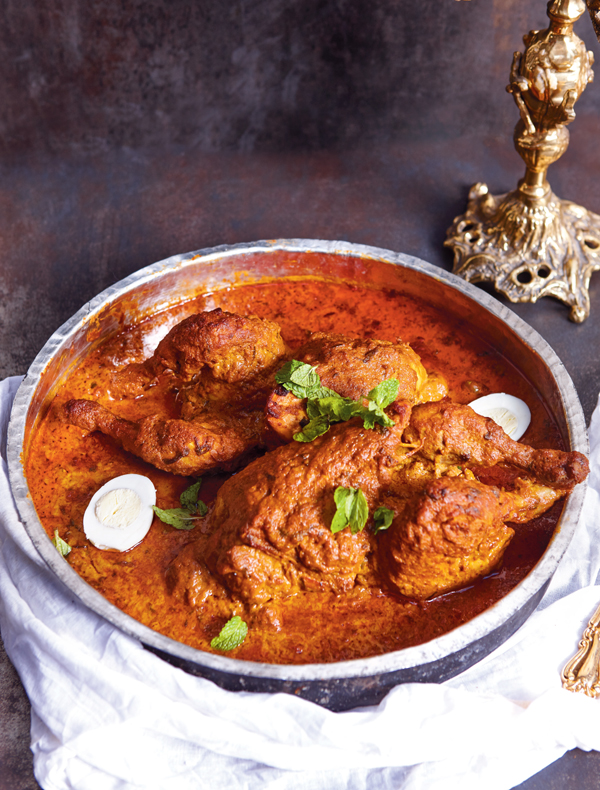
DHUM KA MURGH
INGREDIENTS
1 chicken, weighing approximately 1kg
¼ kg yogurt
2 bunches coriander leaves, finely chopped
1 bunch mint leaves, finely chopped
1 large onion, finely sliced
4 green chillies, slit
Juice of 1 lime
½ cup milk
1 dessert spoon ginger-garlic paste
1 teaspoon garam masala powder
1 teaspoon saffron strands
A few drops of lemon-yellow food colouring
Salt to taste
Flour to seal
Lightly roast and grind
1 dessert spoon poppy seeds
1 dessert spoon chironjee seeds
1 teaspoon all-spice
METHOD
Fry the onion slices to a golden brown. Remove onto a plate lined with absorbent paper, and let cool. Mash the fried slices into a crumble and keep aside. Strain the oil into a bowl.
Place the chicken in a deep bowl. To this bowl, add ginger-garlic paste, garam masala, roasted and ground spices, fried onions and the oil. Let marinate for an hour.
Dissolve saffron strands in milk in the meantime.
After an hour, place the chicken pieces on a flat pan or lagan. Add the marinade and sprinkle with the saffron-infused milk. Then, squeeze the juice of a lime and add a few drops of lemon-yellow food colouring. Mix everything well.
Seal the lagan with flour and place coals above and below. Cook on a slow and low flame. If you do not have a lagan, you can place the chicken pieces, marinade, milk, lime juice and food colouring in a thick-bottomed pan or vessel.
Cover with a tightly-fitting lid. Place the pan on the stove, and leave the flame on high for 10 minutes. Then, reduce it to a low flame and let cook for 15-20 minutes.
Check the chicken pieces for doneness. Once they are cooked, add chopped coriander and mint leaves and slit green chillies. Leave the chicken on dhum for a while, until the oil rises to the surface.
Serve garnished with coriander and mint leaves and, if you wish, more lime juice. °
